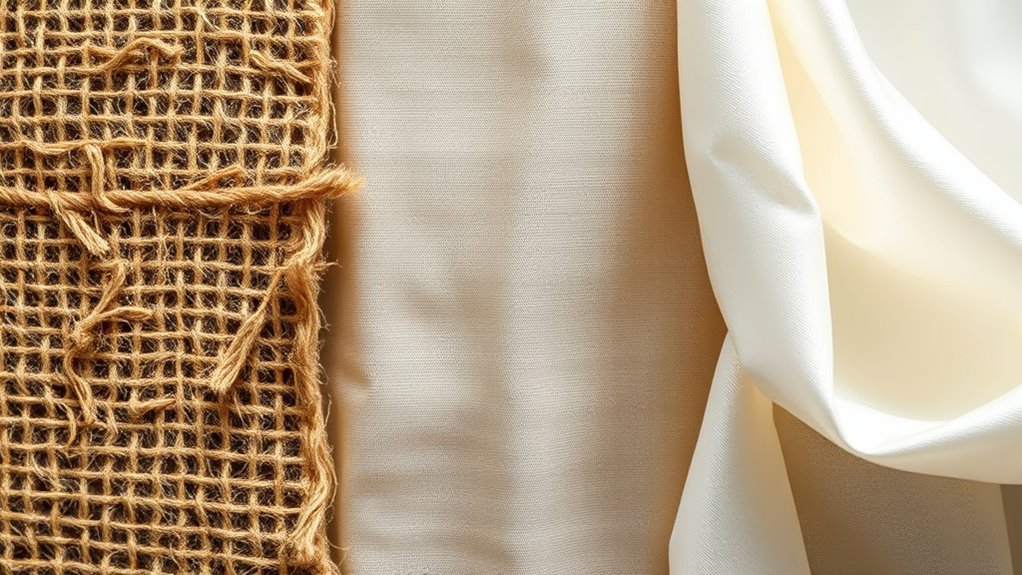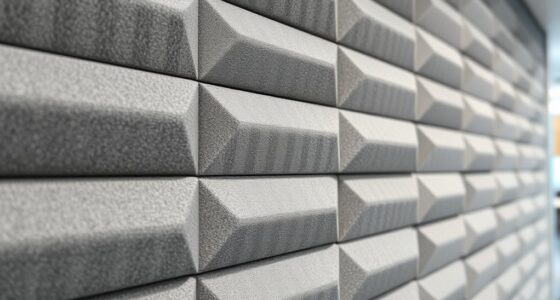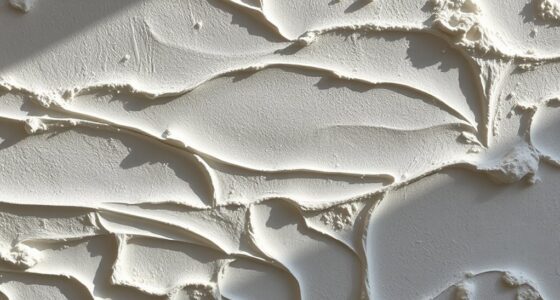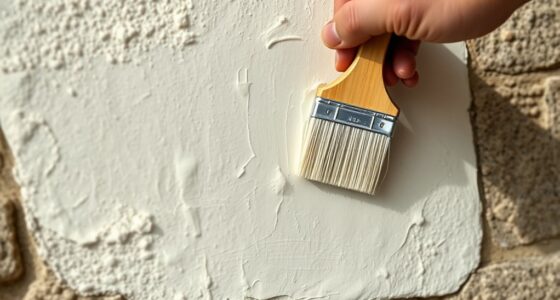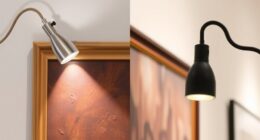Fabric wallcoverings like burlap, linen, and silk each bring unique textures and styles to your space. Burlap offers a rustic, durable look perfect for casual areas, while linen provides a refined, breathable feel suitable for cozy environments. Silk adds elegance with its smooth sheen, ideal for sophisticated spaces. Understanding their qualities, installation tips, and maintenance can help you choose the right fabric. If you’re interested, you’ll discover more about how to incorporate these fabrics effectively.
Key Takeaways
- Burlap offers a coarse, rustic texture and high durability, ideal for casual or industrial wallcoverings.
- Linen provides a refined, breathable surface with a balance of softness and strength, suitable for cozy or farmhouse styles.
- Silk features a smooth, lustrous finish that adds elegance and sophistication but requires delicate handling and maintenance.
- Durability varies: burlap and linen are more suited for high-traffic areas, while silk is best for decorative or formal spaces.
- Fire resistance and eco-friendly options are important considerations when choosing fabric wallcoverings for safety and sustainability.
Characteristics and Textures of Burlap, Linen, and Silk Wallcoverings
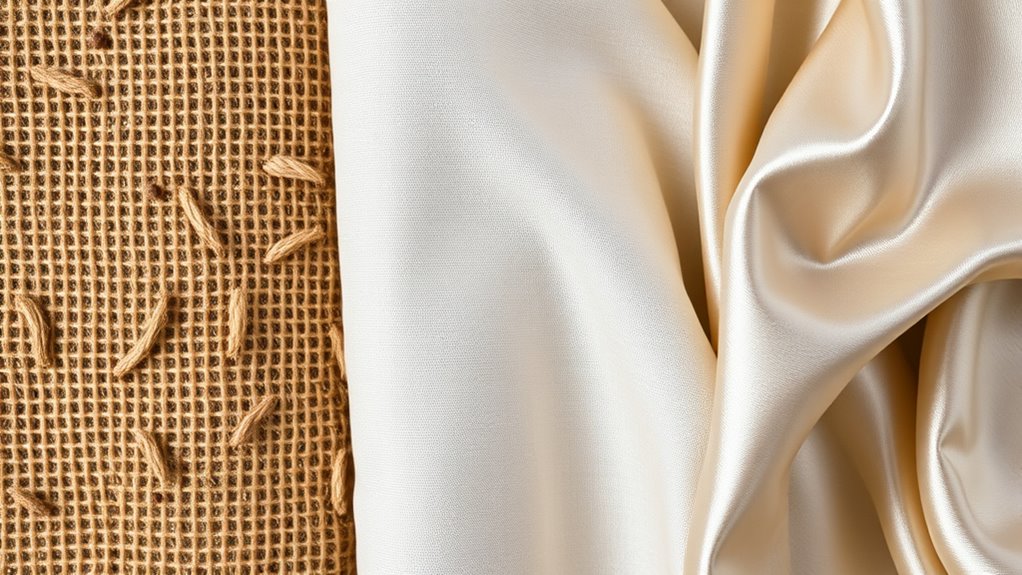
Burlap, linen, and silk wallcoverings each bring unique textures and character to a space. You’ll notice texture variations that add depth and visual interest to your walls. Burlap offers a coarse, rustic feel with a rugged appearance, making it ideal for casual or industrial styles. Linen provides a more refined, slightly coarse texture that feels natural and breathable, adding subtle elegance. Silk, on the other hand, boasts smoothness and a subtle sheen, giving a luxurious touch to any room. When considering fabric durability, burlap is the most resilient, though it’s prone to fraying if not properly finished. Linen strikes a good balance between durability and softness, while silk requires more delicate handling but offers unmatched elegance. Each material’s characteristics influence how you incorporate them into your space. Incorporating these fabrics into a bedroom, especially in a farmhouse style, can enhance the cozy and inviting atmosphere. Understanding fabric durability and care can help maintain the beauty of these wallcoverings over time. Additionally, considering texture differences can help you select the right fabric to complement your overall interior design. Moreover, selecting the appropriate fabric can also impact the overall aesthetic and ambiance of your space, making it more personalized and inviting.
Design Styles and Aesthetic Appeal of Fabric Wallcoverings

Fabric wallcoverings instantly elevate a space by adding texture and warmth, making them a versatile choice for various design styles. You’ll find a wide range of fabric pattern options, from subtle weaves to bold prints, allowing you to create different aesthetic effects. For a classic look, choose patterns like florals or damasks, while modern spaces benefit from geometric or abstract designs. Color palette coordination is key; soft neutrals create calm environments, whereas vibrant hues add energy. You can also mix textures and patterns for a layered, eclectic feel. Whether aiming for elegance or contemporary flair, fabric wallcoverings offer the flexibility to express your style and enhance your room’s overall aesthetic. Establishing a timely resolution when selecting and installing fabric wallcoverings can help ensure your project stays on schedule and within budget. Additionally, selecting appropriate fabric types can improve durability and ease of maintenance, making your wallcoverings more suitable for everyday living. Paying attention to fabric care and cleaning methods can further extend the lifespan of your wallcoverings and keep them looking their best over time.
Installation Tips and Techniques for Fabric Wallcoverings

Before installing fabric wallcoverings, you need to prepare the surface properly to guarantee a smooth finish. Pay close attention to applying the fabric evenly and matching seams seamlessly for a professional look. Mastering these key techniques will make your installation look polished and durable.
Surface Preparation Essentials
Proper surface preparation is essential for ensuring your fabric wallcovering adheres smoothly and lasts. To maximize fabric wallcovering durability, start with the right surface preparation tools, like sanding blocks, primer, and cleaning supplies. Here are four key steps to follow:
- Clean the wall thoroughly to remove dust, grease, and old adhesives. Proper cleaning helps prevent future peeling or bubbling. Using a cleaning method suitable for the wall surface can further enhance adhesion. Additionally, understanding the role of surface porosity can help determine the best cleaning approach.
- Repair any holes or cracks for a smooth surface.
- Sand glossy or uneven areas to promote better adhesion. Using a proper sanding technique can significantly improve the bonding process.
- Prime the wall with an appropriate primer to create a uniform base.
- For optimal results, consider surface preparation techniques that ensure a flawless finish.
Applying and Seaming Techniques
Once you’ve prepared the wall surface, precise application and seamless seaming are essential to achieving a professional look. To start, choose the right adhesive based on your fabric type—some require specialty wallcovering adhesives for ideal bonding. When applying, ensure the fabric is aligned correctly and smooth out bubbles or wrinkles as you go. For seaming, use consistent pressure along the edges to create tight, invisible joints. Hand sewing techniques come into play when seams need reinforcement or a clean finish, especially with delicate fabrics like silk or linen. Use a fine needle and matching thread to carefully stitch along the seam, keeping stitches neat and unobtrusive. Proper adhesive selection and skilled hand sewing help ensure your fabric wallcovering looks flawless and lasts. Paying attention to fabric compatibility is crucial to ensure the adhesive and sewing techniques work effectively with your chosen material, especially considering WWE Raw’s financial impact and how it influences industry standards. Additionally, understanding the seaming techniques can help prevent issues like bubbling or peeling over time, ensuring a durable finish. Incorporating professional installation tips can further enhance the longevity and appearance of your wallcovering.
Maintenance and Care for Different Fabric Types
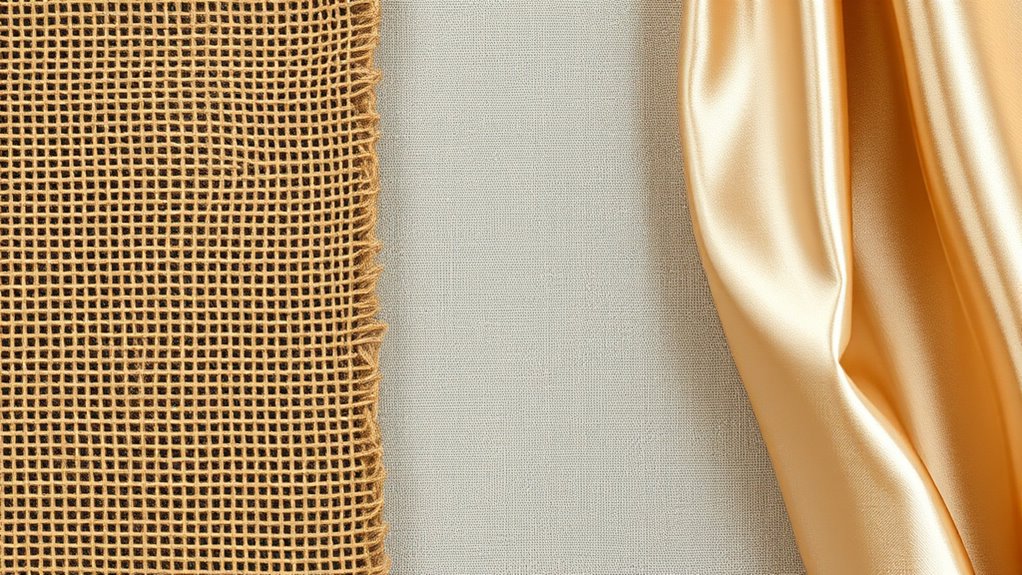
Different fabric wallcoverings require specific maintenance techniques to keep them looking their best. To maintain their appearance, consider these essential steps:
- Dusting techniques: Regularly dust with a soft cloth or vacuum using a brush attachment to remove surface dirt. Incorporating gentle dusting helps preserve the fabric’s texture and appearance. Dusting techniques are especially important for delicate fabrics like silk and linen.
- Stain removal: Address stains immediately with a gentle, fabric-appropriate cleaner, avoiding excessive rubbing. This prevents permanent damage and maintains fabric integrity.
- Avoid excess moisture: Keep fabrics dry; avoid over-wetting, which can cause damage or mold. Proper fabric care ensures longevity and prevents deterioration.
- Gentle cleaning: For delicate fabrics like silk, opt for light, dry cleaning methods or professional services when needed. Proper paint sprayer maintenance ensures the longevity of your equipment and a pristine finish.
Choosing the Right Fabric for Your Space and Needs
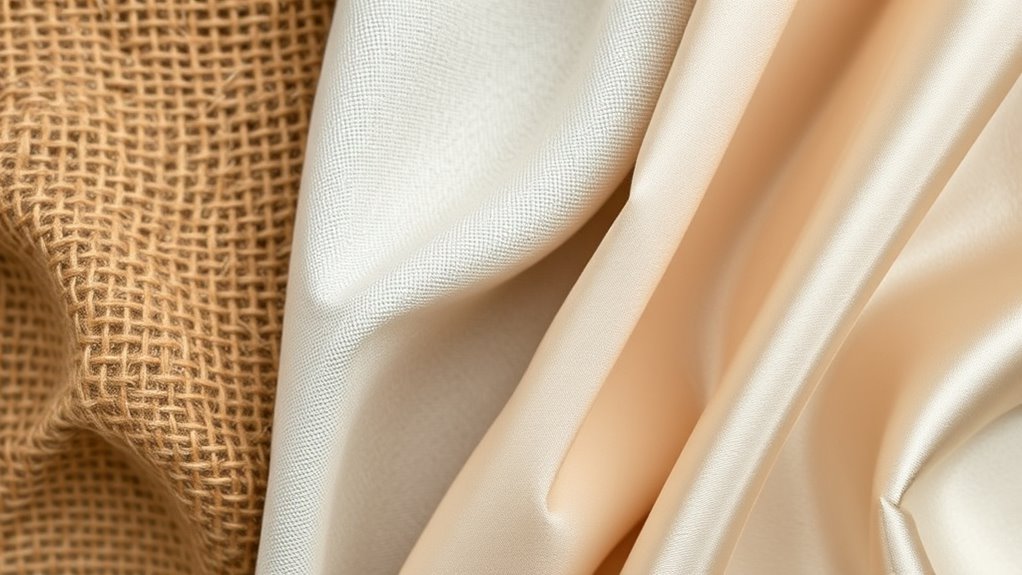
Selecting the right fabric for your wallcovering depends on understanding your space’s function, lighting, and desired aesthetic. Consider fabric durability—some materials like linen and burlap are sturdy and suitable for high-traffic areas, while silk offers elegance but less resilience. Fire resistance is essential, especially in commercial or public spaces; choose fabrics treated for fire retardance or inherently flame-resistant. Think about how much wear and tear your walls will endure and whether the fabric’s texture complements your decor. For example, durable fabrics like burlap work well in rustic settings, while silk adds luxury in formal rooms. Matching fabric qualities to your needs ensures longevity and safety, helping you create a stylish, functional environment. Additionally, understanding the self-watering plant pots system can inspire similar principles of moisture management in fabric selection, emphasizing durability and safety for long-lasting wallcoverings. Being aware of the net worth of various materials and their market value can also guide you in choosing high-quality fabrics that offer better durability and value over time. Moreover, consulting local resources and tools can help you find expert advice on fabric care and installation techniques, ensuring your wallcoverings maintain their beauty over the years.
Enhancing Your Interior With Fabric Wallcoverings
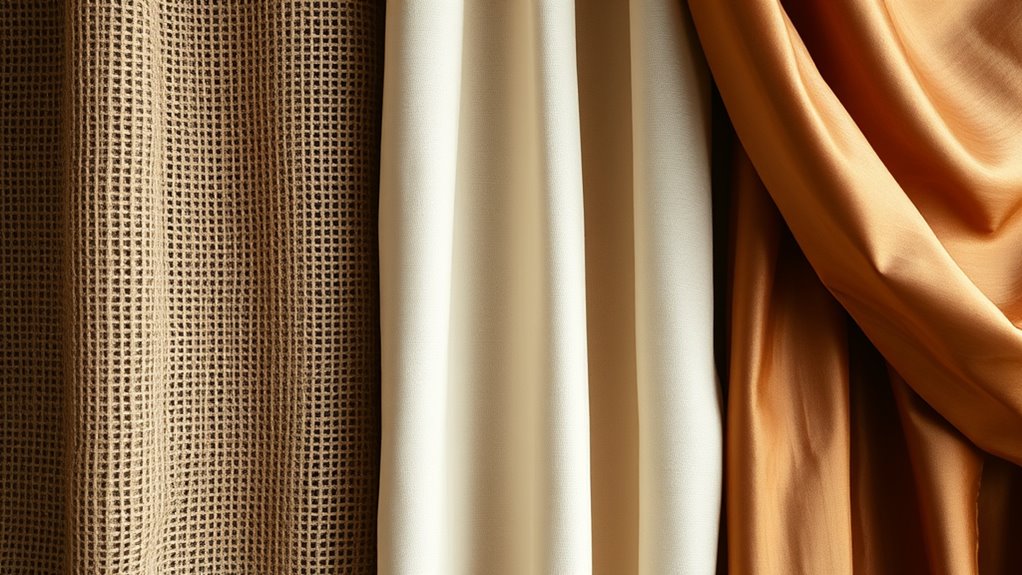
Fabric wallcoverings instantly elevate your interior by adding texture, warmth, and visual interest to any space. To make the most of this, consider these options:
- Historical influences: Incorporate vintage-inspired patterns or traditional techniques to create a rich, timeless look.
- Eco-friendly options: Choose sustainable fabrics like hemp, organic linen, or recycled silk to reduce environmental impact.
- Layering textures: Mix fabrics such as burlap with silk for depth and contrast, enhancing the room’s character.
- Color coordination: Match fabric shades with your existing decor to create harmony or introduce bold hues for a statement. Many fabric wallcoverings also reflect eco-friendly trends, helping you design beautifully while supporting sustainability. Embracing these elements allows you to craft an interior that’s both stylish and environmentally conscious. Incorporating natural materials such as unique and wicked planters can further complement your space, blending natural elements with your fabric choices.
Frequently Asked Questions
How Eco-Friendly Are Natural Fabric Wallcoverings Like Burlap, Linen, and Silk?
Natural fabric wallcoverings like burlap, linen, and silk are generally eco-friendly because of sustainable sourcing and biodegradability considerations. You’ll find they often come from renewable resources, reducing environmental impact. Plus, these materials break down naturally over time, making them a greener choice. Just check for certifications and eco-friendly dyes to guarantee you’re making the most sustainable decision for your space.
Can Fabric Wallcoverings Be Removed or Replaced Without Damaging Walls?
Of course, you can remove or replace fabric wallcoverings without damaging your walls—if you’re prepared for a delicate dance. Use gentle removal techniques like steaming and peeling, and prep your walls with primer or adhesive remover to prevent tears. Patience is key; rushing could turn your walls into a canvas of chaos. With careful wall preparation, your walls stay intact, ready for the next stylish adventure.
Are Fabric Wallcoverings Suitable for High-Humidity or Outdoor Areas?
Fabric wallcoverings are generally not suitable for high-humidity or outdoor areas because they lack moisture resistance and outdoor durability. You’ll find that exposure to moisture can cause mold, mildew, and damage to the fabric. If you want a resilient wallcovering for these spaces, consider options specifically designed for outdoor use, such as vinyl or treated fabrics that offer better moisture resistance and outdoor durability.
What Are the Cost Differences Among Burlap, Linen, and Silk Wallcoverings?
Burlap wallcoverings are generally the most affordable, making them a great choice if you’re on a tight budget. Linen falls in the mid-range, offering a more refined look without breaking the bank. Silk, however, is the most expensive, prized for its luxury and elegance. When considering cost comparison, think about your budget considerations and how much you’re willing to invest in quality and style for your space.
How Do Fabric Wallcoverings Impact Indoor Air Quality?
They say, “What’s hidden often causes the most trouble.” Fabric wallcoverings can impact indoor air quality by releasing airborne fibers that may trigger allergies. Over time, allergen accumulation can occur, especially in fabrics like burlap, linen, and silk. Regular cleaning and choosing hypoallergenic options help reduce these effects. You should stay vigilant to maintain a healthy environment and prevent potential respiratory issues caused by trapped allergens.
Conclusion
Choosing the right fabric wallcovering transforms your space beautifully. Imagine a cozy living room with burlap accents adding warmth or a luxurious bedroom featuring silky textures that invite relaxation. By understanding each fabric’s characteristics and caring for them properly, you’ll create a stunning, inviting environment that reflects your style. Whether you opt for linen’s natural elegance or silk’s opulence, your thoughtfully selected wallcovering can truly elevate your home’s ambiance.
